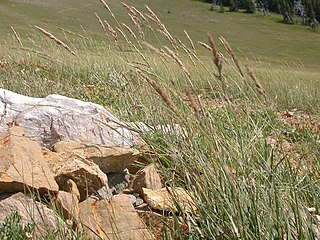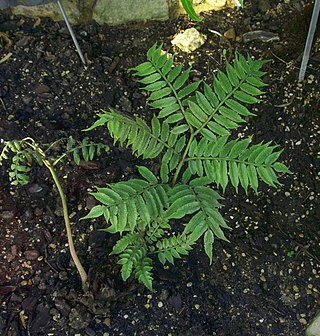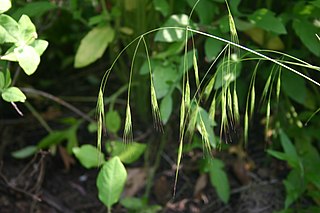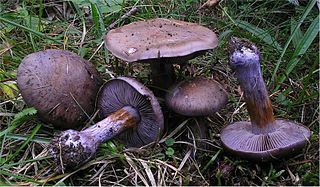
Salvia officinalis, the common sage or sage, is a perennial, evergreen subshrub, with woody stems, grayish leaves, and blue to purplish flowers. It is a member of the mint family Lamiaceae and native to the Mediterranean region, though it has been naturalized in many places throughout the world. It has a long history of medicinal and culinary use, and in modern times it has been used as an ornamental garden plant. The common name "sage" is also used for closely related species and cultivars.

Calamagrostis purpurascens, is a perennial grass commonly known as purple reedgrass, purple pinegrass, or alpine reedgrass.

The crested guan is a Near Threatened species in an ancient group of birds of the family Cracidae, which are related to the Australasian megapodes or mound builders (Megapodiidae). It is found from central Mexico through Central America and in Colombia, Ecuador, Peru, and Venezuela.

The Field Elm cultivar Ulmus minor 'Purpurascens' was listed by Lavallée in Arboretum Segrezianum (1877) as U. campestris var. purpurascens (purpurea), but without description, and later by Schneider in Illustriertes Handbuch der Laubholzkunde (1904). Krüssmann in Handbuch der Laubgehölze (1962) identified it as a cultivar.

Ptisana purpurascens is a species of fern in the family Marattiaceae that is endemic to Ascension Island. It is considered a critically endangered species.

The imperial shag or imperial cormorant is a black and white cormorant native to southern South America, primarily in rocky coastal regions, but locally also at large inland lakes. Some taxonomic authorities, including the International Ornithologists' Union, place it in the genus Leucocarbo, others in the genus Phalacrocorax. It is also known as the blue-eyed shag, blue-eyed cormorant and by many other names, and is one of a larger group of cormorants called blue-eyed shags. The taxonomy is very complex, and several former subspecies are often considered separate species.

Goodenia is a genus of about two hundred species of flowering plants in the family Goodeniaceae. Plants in this genus are herbs or shrubs, mostly endemic to Australia. The leaves are variably-shaped, the flowers arranged in small groups, with three or five sepals, the corolla bilaterally symmetrical and either fan-shaped with two "lips" or tube-shaped. The petals are usually yellow to white, the stamens free from each other and the fruit a capsule.
Ascaptesyle is a genus of moths in the subfamily Arctiinae.

Pratia is a formerly recognized genus of flowering plants in the family Campanulaceae, native to Asia, Australia and New Zealand. Along with other genera, such as Hypsela and Isotoma, it is now included in Lobelia.
Drosera purpurascens is a compact tuberous perennial species in the genus Drosera that is endemic to south-west Western Australia. It produces 1 erect or 2 to 5 semi-erect lateral stems that grow to 3 to 10 cm long. The compact size of the plant combined with relatively long petioles distinguish it from all other members of the section Stolonifera. It is native to a region from Mount Cooke to near Katanning and Ongerup south to the Denmark-Albany region. It grows in sand-laterite soils and flowers from July to October, flowering en masse after bushfires.
Allaxitheca is a monotypic moth genus in the family Geometridae described by Warren in 1897. Its only species, Allaxitheca purpurascens, was first described by Frederic Moore in 1888.
Xanthograpta purpurascens is a moth of the family Noctuidae first described by George Hampson in 1910. It is found in Australia.

Schizachne is a genus of Eurasian and North American plants in the grass family. The only accepted species is Schizachne purpurascens, commonly called false melic. Three subspecies are recognized:

Conus purpurascens, common name the purple cone, is a species of sea snail, a marine gastropod mollusk in the family Conidae, the cone snails and their allies.

Thaxterogaster purpurascens is a species of mushroom producing fungus in the family Cortinariaceae. It is commonly known as the bruising webcap.

Sthenopis purpurascens, the four-spotted ghost moth, is a species of moth of the family Hepialidae. It was described by Packard in 1863. It is found in Canada and the United States, from Labrador and New York north and west to British Columbia and the Northwest Territories, south in the mountains to Arizona.
Somatina purpurascens is a moth of the family Geometridae first described by Frederic Moore in 1887. It is found in Sri Lanka.
Ascaptesyle submarginata is a moth of the subfamily Arctiinae. It was described by William Schaus in 1905. It is found in Trinidad. No subspecies are listed in the Catalogue of Life.

The Elm cultivar Ulmus 'Myrtifolia Purpurea', the Purple Myrtle-leaved Elm, was first mentioned by Louis de Smet of Ghent (1877) as Ulmus myrtifolia purpurea. An U. campestris myrtifolia purpureaHort. was distributed by Louis van Houtte in the 1880s, by the Späth nursery, Berlin, in the 1890s and early 1900s, and by the Hesse Nursery, Weener, Germany, till the 1930s.

The brown kukri snake is a species of snake of the family Colubridae.













